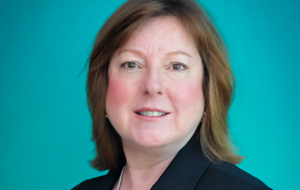Editor's Note: This is the second in a series of Q&As covering the winners of the Georgia CIO Leadership Association CIO of the Year Awards.
The Georgia CIO Leadership Association's (GeorgiaCIO) annual awards event draws the active participation of more chief information officers than any other event in Georgia. The group's focus on providing a friendly, sales pitch-free atmosphere for CIOs and technology leaders to meet and share ideas is likely a big reason why.
 “It’s really about us coming together, helping each other, and helping the community,” said Nancy D'Amico, CIO of vehicle leasing and fleet management solutions provider LeasePlan USA. “There’s a lot of camaraderie, and you really do feel good participating in the GeorgiaCIO.”
“It’s really about us coming together, helping each other, and helping the community,” said Nancy D'Amico, CIO of vehicle leasing and fleet management solutions provider LeasePlan USA. “There’s a lot of camaraderie, and you really do feel good participating in the GeorgiaCIO.”
D'Amico was recently recognized by GeorgiaCIO as CIO of the Year award in the Corporate category, and we caught up with her to learn more about the accomplishments that led to this prestigious recognition.

The Enterprisers Project (TEP): One of the achievements that led to your award win was your transformation of the IT department at LeasePlan USA – from a cost center to an investment center. Could you tell us more about that?
 D'Amico: When I started here in 2008, there were big walls in-between IT and the business, and a lot of frustration on both sides. I needed to get a better understanding of what we were doing within IT. So, I met with everyone one-on-one — about 60 people at the time. I also met with the business leaders, and I learned there was not a lot of clear accountability or responsibility within the technology team. That was significantly impacting their ability to work with the business and meet project commitments in an efficient and timely manner.
D'Amico: When I started here in 2008, there were big walls in-between IT and the business, and a lot of frustration on both sides. I needed to get a better understanding of what we were doing within IT. So, I met with everyone one-on-one — about 60 people at the time. I also met with the business leaders, and I learned there was not a lot of clear accountability or responsibility within the technology team. That was significantly impacting their ability to work with the business and meet project commitments in an efficient and timely manner.
Meeting product commitments is something I consider to be one of the basics of IT. If you can’t get your commitments right, you’re not going to be able to start working on the fun, cool stuff — like emerging technologies. So we addressed the basics and, at the same time, put in place an IT strategy for how we were going to work together to make the business better for our employees and our clients.
From there we set to work transforming all of our internal applications that support the business — and ultimately the client — from our legacy environment to more open technology. For example, we moved from COBOL and RPG to Java and service-oriented architecture. We also started leveraging agile scrum as a development methodology. By implementing newer technologies and techniques we were able to deliver more value, faster. And now, our technology vision is focused on innovation, information and integration to drive the business forward.
TEP: How did you get the technology team on board with this new vision for IT?
D'Amico: I really focused on modeling the behaviors that I wanted to see more of throughout the team. And I worked hard to establish a relationship with the rest of the executive management team, focusing on solving business problems versus building technology. Our CEO and I strive to work together to really make a difference for our clients — adding business value, versus just doing technology for technology's sake.
I'm also involved in our quarterly all-employee town hall meetings. It’s an opportunity to present the technology vision alongside where the company is headed as a whole. I share what we’ve delivered, and what’s coming next from the IT team. Now, there’s a lot more visibility to the problems we’re solving and the solutions we provide.
TEP: Did your IT transformation bring to light any skill gaps or create any hiring challenges for you?
D'Amico: I found that some of the best people on the technology team — the ones that had a lot of business knowledge — were the ones that had been around the longest. I have people on my team that have worked at this company for 35 years. I have a very low attrition, so hiring doesn’t happen a lot. But from account development perspective, and in shifting from our legacy system to a more open platform with service-oriented architecture, I did give everyone the opportunity to make that shift if they wanted to. I worked with them to learn the new technology. Then I brought in professors and architects to help get them up to speed. Almost everyone decided to give it a try.
The hires that I did make a few years ago were more senior-level staff, because I needed their expertise while others were learning new technology skills. Now we’re starting to hire recent college grads, which is helping us continue to evolve the culture by bringing in new ideas, new techniques and new capabilities. It's exciting, because we’ve earned the right to start working on the more innovative product offerings to better serve our clients, both internally and externally.
TEP: Do you have any advice for other CIOs who are seeking to change the culture within their organizations?
D'Amico: You have to get the basics right. Your operations need to be stable, and you need to meet your project commitments. Then you’ll earn the opportunity to work with the business to help bring to market new, innovative business products by leveraging technology. I would also recommend spending a lot of time with your business peers. I try to spend at least 60 percent of my week with my business partners and their teams.
We recently renovated our office space and during that process the architects asked me where I wanted the IT team. I told them, “Technology needs to be right there in the middle of the business. We need to be in the middle of it all.” And they were kind of surprised by that. They said usually that’s not the case. But I argue that location is important when closer proximity means potentially closer collaboration. I know there are a lot of companies moving toward virtual offices and remote workers – and we definitely have some of that, too. But having the team visible – not behind closed doors - has made a critical difference in how IT interacts with the business, and vice versa. The walls have come down — literally and figuratively.






